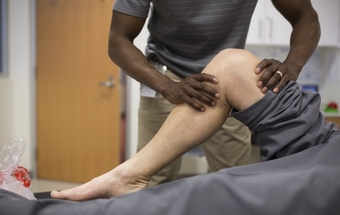It was during a high school career day that H. David Homesley Jr. told his dad he thought he just might follow him into medicine.
The senior Dr. Homesley, a women's cancer surgeon, had a passion for his practice that was contagious, his son recalled.
About David Homesley Jr.
"We'd meet up for lunch and he would disappear, and he'd be on the pay phone, checking his voice mail, leaving messages, making sure people (colleagues and staff) would know what to do with his patients, because he dealt with a lot of very sick patients. Despite that, he always had a positive attitude," Homesley Jr. said. "He truly loved his job and he was never intimidated by technology."
Those who work with Dr. David Homesley with Novant Health Orthopedics & Sports Medicine - Cotswold describe him in much the same way.
"He's one of the best — and busiest — total joint surgeons in the country," said Dr. Bryan Edwards, senior vice president of Novant Health Orthopedic & Sports Medicine Institute. "He's very precise, very methodical, very meticulous."
Homesley, 51, has staked his career on doing two things very well — replacing hips and knees. It's a specialty that satisfies his penchant for problem-solving and his fascination with new technology. He performs about 1,000 joint replacements a year, many with the aid of computer-assisted robotics.
"One of the things my training drove home to me is that it's hard to be good at everything, and doing the same thing over and over again, you just get better and better at it," Homesley said.
It's a strategy that has gained nationwide notice.
When Carrum Health, a digital health company that links employers to medical care, needed a North Carolina partner for orthopedic surgery, it turned to Novant Health. The California company is notoriously choosy: It picks only providers who are in the top 10% nationwide.
"Novant Health Charlotte Orthopedic Hospital is the first hospital in North Carolina to be selected by Carrum as a Center of Excellence, and they selected Dr. Homesley as their surgeon of choice," Edwards said. "So now we have patients coming from across the Southeast to have surgery by Dr. Homesley."
In Homesley, those patients have a doctor who embraces leading-edge medicine and also hews to old-fashioned courtesies, like returning patients' phone calls after hours.
"He's still one of the old-school doctors who is always available," Edwards said. "I think he got a lot of that from his dad."
Surgery is a last resort
Treating his patients as partners is another. For those who have exhausted other treatments for knee or hip pain, replacing a damaged joint with metal, ceramic and plastic can be a safe and effective way to relieve pain and restore mobility.
"We make that decision together," Homesley said. "We try to do it as a last resort, when a patient's quality of life is getting so poor from the pain that they are having trouble walking and sleeping and doing their everyday activities. That's when we start talking about hip or knee replacement."
His typical patient is in their early 60s, but he has operated on 20-somethings as well as folks nearing the century mark. Young or old, patients are urged to ask questions, and Homesley makes it a point to respond simply, yet specifically.
"The more my patients understand, the better they'll do," he explained.
Before they go anywhere near the operating room, Homesley insists patients get into the best shape they can — a step known as pre-optimization. That means those who smoke need to stop. (It can impede healing and cause complications.) Those who are overweight or obese are urged to lose weight. Managing blood sugar and iron levels is also important.
For Homesley, managing expectations is, as well.
"If a patient's expectation is that they're never going to have pain, that their new knee is going to feel like a normal knee, I tell them, 'A knee replacement isn't going to feel like the knee that God gave you. It's a mechanical device,' " he said.
As partners in health, surgeon and patient both have vital roles to play in the process.
"It's equally as important for me to do a good job on the surgery as it is for them to do a good job on the physical therapy after," Homesley said.
Harnessing the latest technology

For his part, Homesley has had plenty of practice. Since completing a fellowship in adult reconstructive surgery at Thomas Jefferson University Hospital in Philadelphia in 2003, he has done thousands of arthroplasties — the medical term for joint replacements.
In recent years, robotics has emerged as a precision tool in Novant Health's arthroplasty arsenal. Homesley, an expert in deploying the Mako Stryker robot, also coaches younger colleagues in its use.
The technology is revolutionary: Before surgery, it uses a CT scan to generate a 3D virtual model of the patient's joint. Homesley uses that to determine the size and placement of the new hip or knee. Then, in the OR, the model helps him fine-tune his plan based on his examination of the patient's anatomy and range of motion.
Finally, when parameters are set, Homesley guides the robotic arm to remove the diseased bone and cartilage. Visual cues on a computer screen tell him exactly how much bone to shave away — ensuring that only damaged tissue is removed. Then, the patient gets a new joint.
The technology is so new that some insurers consider it investigational and won't cover it, but some patients demand it, nonetheless. Homesley said it will take about 10 years of data from thousands of joint replacements around the world to declare any method better than another.
One thing is clear: Whether robot-assisted or traditional, arthroplasty is demanding work.
Homesley operates three days a week, with a team of staff, anesthesiologists and physician assistants. His day averages 10 to 12 hours.
"It's very physical — you're standing a lot in the operating room," he said, "But I enjoy coming home tired and feeling like I've accomplished something."
Helping patients live their dream
Homesley also understands the importance of recharging. In his off hours, he enjoys working out and playing video games.
He also enjoys time at home with his wife, Natalie, and their sons, Jack, 22, and Alex, 19. Before the young men left for college, Homesley followed his father's lead and carved out time to coach their youth soccer teams. They also have a passion for skiing — a tradition that recalls Homesley's own ski trips with his dad.
Edwards said Homesley strikes a perfect balance of dedication to his patients and also to his family.
"He's going to get you back to the golf, the tennis, the playing with your grandchildren — whatever it is that you want back into your life," he said. "Dave Homesley's the guy who can get you there."
More knee surgeries coming
Nationwide, the number of knee replacements are growing every year. As the population ages and issues like obesity cause more wear and tear on joints, total knee replacements are projected to grow more than 600% to 3.5 million a year by 2030.
What to expect
Patients preparing for joint replacement are often surprised to learn that they won't have general anesthesia. Thanks to regional and spinal anesthesia, they'll be unaware during surgery, but they won't need a breathing tube down their throat to move air to and from their lungs. They'll also be awake and alert sooner afterward. Many are discharged the same day, and most begin physical therapy the next — often in their own home.













